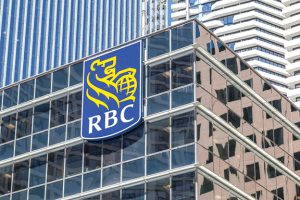Bloomberg
Royal Bank of Canada’s (RBC) profit took a hit last quarter as a slump in investment-banking activity took a toll on revenue and a deteriorating economic outlook prompted higher-than-expected provisions for loan losses.
RBC Capital Markets’ revenue falls by a third to $1.27 billion in the fiscal third quarter, the Toronto-based bank said in a statement. Overall profit missed analysts’ estimates.
Royal Bank’s investment-banking revenue was slammed by plunging equity markets that dried up investor demand for initial public offerings (IPOs) and share sales, along with C$385 million in markdowns on loans it had underwritten. Despite the quarter’s turbulent markets, trading revenue also fell, failing to counter the hit from the
investment-banking downturn.
“Investment banking in particular was much weaker than people expected, even accounting for those markdowns,†Paul Gulberg, an analyst at Bloomberg Intelligence, said in an interview. “People knew there were no IPOs, they knew there was much weaker M&A, but it was still down a lot.â€
Royal Bank’s shares have slipped 8.7% this year, compared with an 9.9% drop for the S&P/TSX Commercial Banks Index. RBC Capital Markets’ net income falls 58% to C$479 million. Corporate and investment banking revenue slid 52% to C$625 million, with the markdowns resulting in investment-banking revenue of negative C$26 million. Revenue from global markets dropped 7.3% to C$1.14 billion.
“The results of our capital-markets platform this quarter do not reflect the strength of this premium franchise, nor the potential of its performance going forward,†Chief Executive Officer Dave McKay said on a conference call with analysts. “Results were impacted by an industrywide decline in fee pools along with the disruption in high-yield and broader credit markets.â€
At Royal Bank, companywide net income falls 17% to C$3.58 billion, or C$2.51 a share. Excluding some items, profit was C$2.55 a share. Royal Bank’s results also were weighed down by higher-than-expected provisions for credit losses, which the company said were “mainly due to unfavorable changes in our macroeconomic outlook.†The lender set aside C$340 million in provisions, more than the C$296.8 million analysts had projected, marking a reversal from the C$342 million of releases in previous three months.
The higher provisions were largely a result of forecasts for economic weakness ahead rather than any current signs of trouble, Chief Financial Officer Nadine Ahn said. Unemployment remains low, and customers are sitting on extra cash that should cushion them against strains, she said.
The bank’s common equity tier 1 capital ratio was little changed at 13.1%, compared with 13.2% at the end of the second quarter.
Despite the gloomier outlook, Royal Bank’s domestic banking operations underscored a Canadian economy that’s still performing well for now. Revenue in the division climbed 11%, helped by rising balances of mortgages, credit cards and small business loans.
Net income for the unit fell, hurt by $331 million in provisions for credit losses, compared with C$122 million in releases a year earlier.
Royal Bank also got a lift from the Bank of Canada’s interest-rate increases, which helped boost its net interest margin to 1.52% last quarter from 1.45% in the second quarter, an expansion that National Bank analyst Gabriel Dechaine called “very strong.â€
 The Gulf Time Newspaper One of the finest business newspapers in the UAE brought to you by our professional writers and editors.
The Gulf Time Newspaper One of the finest business newspapers in the UAE brought to you by our professional writers and editors.
